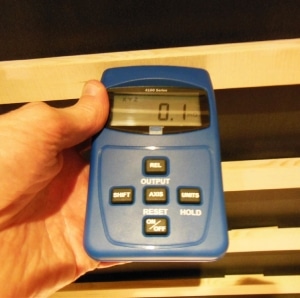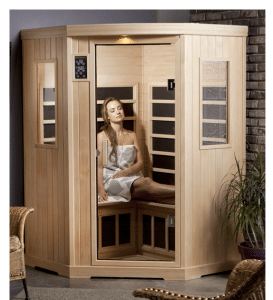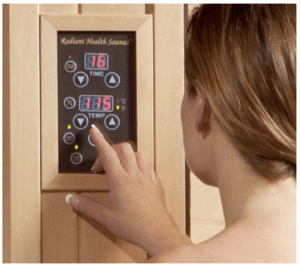Sauna Review Checklist
How an Infrared Sauna Gave Me My Life Back and What to Look for When Buying and Using an Infrared Sauna
Randy Gomm B.Sc.
I have been asked by doctors, other health care practitioners and individuals to put together a detailed infrared sauna review checklist. This would allow them to share and help others who want to know the best infrared sauna features and benefits one should seek when buying or using a superior far infrared sauna. I compiled the information below from in-depth scientific clinical data research as well as from my 25+ years of manufacturing experience in the infrared sauna industry. Thank you to those who have inquired and given me great feedback to create this list.
I have been quite concerned with the information I see shared on websites and the internet about infrared saunas. I think it is important to weed through and verify what information is actually backed by legitimate research and what is simply unsubstantiated opinions shared from website to blog to social media without first checking the facts. Even if one doesn’t buy an infrared sauna from our company, by asking informed questions, it is my hope that one will end up purchasing an infrared sauna that is the most beneficial for their health concerns. More importantly, making sure that an infrared sauna does not contribute more to one’s toxic load.
Years ago, when I was a firefighter in British Columbia, I encountered some major health challenges. My previous high levels of physical activity became very limited and I could no longer work. I was eventually diagnosed with fibromyalgia, also known as chronic fatigue syndrome. However, it turned out that I was actually very high in both toxins and heavy metals. Far infrared sauna turned out to be quite helpful for me. Eventually I returned to work and ever since have enjoyed participating again in the physical activities that I have always loved.
I became so passionate about what the far infrared sauna did for me, I created a company to introduce far infrared sauna therapy to healthcare practitioners, medical doctors, commercial spas, and to individuals for their home use. We have been selling far infrared saunas in Canada and the United States now for over 25 years.
I hope that by sharing this information, it will allow others to use or purchase a superior far infrared sauna.
Important Points and Concerns When Buying or Using an Infrared Sauna:
1. Near vs Far Infrared Saunas
After doing extensive research on near infrared and far infrared, all the legitimate clinical studies on infrared saunas that I could find, cite far infrared technology. I couldn’t find any published clinical research where heaters and or lights used in infrared saunas were in the near infrared range.
Near Infrared (NIR)
I did find some excellent research on near infrared and red light wavelengths but they were using either LED lights or lasers in a very specific frequency of 630-940 nm (nanometers).1 In these hundreds of clinical studies, the LED lights were touching the surface of the skin or within very close proximity to the skin due to the Inverse Square Law*14, which shows that the intensity and effectiveness is dramatically reduced as one moves further away from the light source.
Questions to ask regarding the use of near infrared in a sauna:
1. What is the source of near infrared light found in the sauna?
2. What is the frequency range of the near infrared light?
3. How big is the surface area of the light source?
4. Where is the near infrared light source located and what is the distance from your body in the sauna?
5. Are there published scientific studies that show the benefit and use of near infrared light in a sauna? Are these near infrared studies the same studies that show LED’s used on or very near the skin as noted above?
Far Infrared (FIR)
The human body generates far infrared waves in a range of 6 to 20 microns.
Far infrared is the frequency that is cited in numerous clinical studies on infrared sauna use. LED’s, Red Lights and Low Level Laser Therapy (LLLT) are different frequencies and use different technology as noted below.
Frequency Range :
Far infrared : 3 -1000 microns (or micrometers)
Most of the research papers on far infrared saunas, cite the range of 6 -20 microns.
Near Infrared: 0.7 – 1.4 microns or 700 -1400 nanometers
Red Light : 0.63 – 0.7 microns or 630 -700 nanometers
A far infrared sauna is different than a conventional sauna because the far infrared wavelengths directly penetrate your body and do not heat up the air to the same degree by convection as in a conventional sauna. The beneficial effects of a far infrared sauna are produced at a much lower temperature, usually in the range of 115-150 ºF (46-65ºC) while the temperature range in a conventional sauna is usually between 180-200 ºF.
If there is valid published clinical research that shows near infrared heaters/lights used in an infrared sauna have the same recorded benefits as the near infrared studies using lasers and LED’s, I would appreciate receiving this research. Until that time, I will keep the heat source in our saunas in the far infrared range, for that is what the published scientific studies support.
2. EMF ( Electromagnetic Fields) and infrared saunas.
Electromagnetic Fields (EMF) and Electric Fields (EF) can be emitted by a number of sources like overhead power lines and many appliances both at work and at home.
Some infrared sauna companies downplay the effects of EMF. Working with doctors and other healthcare practitioners over the years, we have found many who state that the effects of EMF are of great concern.
There are a number of research studies addressing health concerns and effects of exposure to EMF; including disruption of the neuroendocrine system in children and adolescents10; and neurobehaviorial issues in children11. EMF exposure has also been shown to promote differentiation in pituitary cells, changes in plasma membrane and influx of intracellular calcium. 12
Gauss or milligauss is a measurement scale used to measure the strength of an electromagnetic field (EMF). EMF levels drop off dramatically with distance. For example: If one was two inches away from a microwave, it might measure 30 mG (milligauss), but moving two feet away, the readings may be zero. Unfortunately, one doesn’t have this luxury when sitting in an infrared sauna.. Therefore, you are likely sitting within one or two inches of the heaters and may also be exposed to other electrical components. If these are not tested or safely addressed, you may be unknowingly exposing yourself to a very high electromagnetic field for an extended period of time.
TCO or Swedish Standards are 2 mG (milligauss) or less at the “point of body contact” (the wooden slats one leans against in front of the heaters in an infrared sauna).
 Many of the infrared saunas on the market (some even stating zero or low EMF) often, in actuality, measure EMF in the 10 -100 mG range. This is because companies often test only the heaters in isolation at a lab and not the entire sauna. This mistakenly leads a sauna user to believe that the entire sauna is low in EMF when this is absolutely not the case. Adding to more confusion, when marketing on websites and in brochures, companies state low EMF but do not disclose that only a heater was tested in a lab. A sauna manufacturer should be able to provide you with a complete, multi-page, documented testing report from a government certified independent lab, stating very clearly that the entire sauna was tested for EMF. If only heaters are tested, then the testing does not include electrical connections, control panels and wiring which can all emit high levels of EMF.
Many of the infrared saunas on the market (some even stating zero or low EMF) often, in actuality, measure EMF in the 10 -100 mG range. This is because companies often test only the heaters in isolation at a lab and not the entire sauna. This mistakenly leads a sauna user to believe that the entire sauna is low in EMF when this is absolutely not the case. Adding to more confusion, when marketing on websites and in brochures, companies state low EMF but do not disclose that only a heater was tested in a lab. A sauna manufacturer should be able to provide you with a complete, multi-page, documented testing report from a government certified independent lab, stating very clearly that the entire sauna was tested for EMF. If only heaters are tested, then the testing does not include electrical connections, control panels and wiring which can all emit high levels of EMF.
If EMF averages are given, all readings should be taken at “point of body contact,” for this is where you sit when using the sauna.
Many sauna companies test EMF’s by testing only heaters in isolation in a lab. Radiant Health Saunas ® are tested with a trifield gauss meter at over 100 different locations within the entire sauna. The average reading in a Radiant Health Sauna sauna is a very low 0.3mG at the “point of body contact”. These are the lowest EMF readings in the industry that we have found. We have spent a great deal of time perfecting the engineering of our saunas thanks to valuable input from hundreds of practitioners and customers. We constantly work to improve safety, comfort and effectiveness.
3. VOC’s (Volatile Organic Compounds)
It is very important to make sure that the environment in the infrared sauna is completely nontoxic.
 A number of infrared sauna companies use plywood, particle board or an engineered wood composite as a less expensive option for framing materials in their saunas. This typically can not be seen after construction has been completed. These materials can off-gas formaldehyde and other VOC’s (Volatile Organic Compounds) that can be detrimental to your health. The United States Environmental Protection Agency (EPA) considers formaldehyde a Group B1 probable human carcinogen13. Inferior heaters and other components inside the sauna can also off-gas chemicals, so it is very important that the whole sauna is being tested in a lab and not just the heaters.
A number of infrared sauna companies use plywood, particle board or an engineered wood composite as a less expensive option for framing materials in their saunas. This typically can not be seen after construction has been completed. These materials can off-gas formaldehyde and other VOC’s (Volatile Organic Compounds) that can be detrimental to your health. The United States Environmental Protection Agency (EPA) considers formaldehyde a Group B1 probable human carcinogen13. Inferior heaters and other components inside the sauna can also off-gas chemicals, so it is very important that the whole sauna is being tested in a lab and not just the heaters.
An infrared sauna company should be able to provide you with independent lab testing where the inside of a brand new sauna was tested for VOC’s so that one knows that when they are using the sauna they are sitting in a pristine, nontoxic environment.
Radiant Health Saunas ® are independently tested by a government certified lab and the entire sauna is shown to have zero VOC’s.
4. Ceramic vs Carbon Fiber heaters
 We have used ceramic heaters in the past and received feedback from the practitioners we work with stating patients and clients encountered hot and cold spots within the sauna. We took this feedback and upgraded our saunas years ago to high quality, carbon fiber heaters utilizing Japanese technology. These carbon fiber heaters provide a much larger surface area of the heater close to the body and more consistent heating. The lower surface temperature of the carbon fiber heaters is also more comfortable and has the benefit of increasing the micron wavelength into the beneficial far infrared range.
We have used ceramic heaters in the past and received feedback from the practitioners we work with stating patients and clients encountered hot and cold spots within the sauna. We took this feedback and upgraded our saunas years ago to high quality, carbon fiber heaters utilizing Japanese technology. These carbon fiber heaters provide a much larger surface area of the heater close to the body and more consistent heating. The lower surface temperature of the carbon fiber heaters is also more comfortable and has the benefit of increasing the micron wavelength into the beneficial far infrared range.
Below are links to research papers supporting our position on far infrared saunas versus near infrared saunas and studies supporting concerns regarding high EMF and VOC levels in infrared saunas. I hope this checklist will assist one in asking specific questions, so they will end up with an infrared sauna that is very beneficial for their health.
We take great pride in the quality of our saunas and stand behind our products. We have carefully crafted and custom engineered our saunas for safety and quality to be completely nontoxic, very low in EMF, and have superior far infrared heater coverage.
If you have any questions about infrared saunas, please give us a call.
All the best,
Randy Gomm B.Sc.
Tel: 604-221-1799 or toll free at 1-888-291-6544
* The Inverse Square law14 from a light source states: the strength of the field is inversely proportional to the square of the distance from the point source of the light. …or stated another way: the light intensity is proportional to 1 over distance squared. What does this mean? It means if you are 5 inches away from the light source, you would only have 1/25 the intensity compared to 1 inch from the source; and if you are 12 inches away, you would only have 1/144 the intensity compared to 1 inch from the light source. It is for this reason that LED lights (in the correct frequency) are placed very close or directly against the surface of the skin.
References
1http://neurosurgery.imedpub.com/contributions-of-near-infrared-light-emittingdiode-in-neurosurgery.pdf
2 http://doc.utwente.nl/71336
3https://www.ncbi.nlm.nih.gov/pubmed/17267744
4https://www.ncbi.nlm.nih.gov/pubmed/16606412
5https://www.ncbi.nlm.nih.gov/pubmed/12773705
6https://www.ncbi.nlm.nih.gov/pubmed/16565566
7https://www.ncbi.nlm.nih.gov/pubmed/15992574
8https://www.ncbi.nlm.nih.gov/pubmed/20154403
9https://www.ncbi.nlm.nih.gov/pmc/articles/PMC2920465
10https://www.ncbi.nlm.nih.gov/pubmed/26841641
11https://www.ncbi.nlm.nih.gov/pubmed/23843999
12https://www.ncbi.nlm.nih.gov/pubmed/16838272
13https://www.epa.gov/sites/production/files/2016-09/documents/formaldehyde.pdf
14https://en.wikipedia.org/wiki/Inverse-square_law



